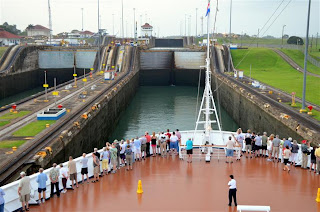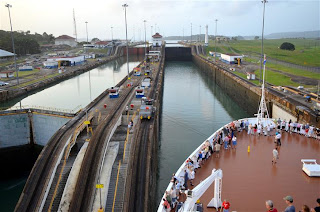 |
| View From Bow of our Ship |
This is our 4th trip through the Panama Canal – our first three on the Norwegian Pearl. We will be back here for another passage in mid-May after circling the world & head for San Diego, our final destination. We had a Lecturer on board throughout our transit today, over the public address system pointing out landmarks, describing the history of the canal & explaining to passengers how the system (the locks) function. I’ll be as concise as possible with this but before I begin, I’d like to briefly share an incident with you. As we were exiting our final ‘lock’, we could hear & see a fire truck and ambulance approaching the Canal. The ship came to a standstill and sure enough, the shoreside workers started rolling a gang-plank toward us. The fire truck and ambulance pulled alongside, and the plank was attached to the ship. By then, all the passengers were hanging over the sides trying to get a glimpse of what was going on. After several minutes, they wheeled a gentlemen out on a stretcher with someone pulling a suitcase. The ‘patient’ was waving at the crowds so he obviously wasn’t in too much pain or distress, but it’s highly unusual for a ship to stop midway through one of the ‘locks’ for any reason. He was subsequently placed in the ambulance and away they went. We don’t have any other information at this point but as we learn more we’ll share it.
 Basically, the history of the Panama Canal goes back to 16th century. After realizing the riches of Peru, Ecuador, and Asia, and counting the time it took the gold to reach the ports of Spain, it was suggested c.1524 to Charles V, that by cutting out a piece of land somewhere in Panama, the trips would be made shorter and the risk of taking the treasures through the isthmus would justify such an enterprise. A survey of the isthmus was ordered and subsequently a working plan for a canal was drawn up in 1529. The wars in Europe and the thirsts for the control of kingdoms in the Mediterranean Sea simply put the project on permanent hold. In 1534 a Spanish official suggested a canal route close to that of the now present canal. Later, several other plans for a canal were suggested, but no action was taken. The Spanish government subsequently abandoned its interest in the canal. In the early 19th century the books of the German scientist Alexander von Humboldt revived interest in the project, and in 1819 the Spanish government formally authorized the construction of a canal and the creation of a company to build it. The discovery of gold in California in 1848 and the rush of would-be miners stimulated America’s interest in digging the canal. Various surveys were made between 1850 and 1875 showed that only two routes were practical, the one across Panama and another across Nicaragua. In 1876 an international company was organized; two years later it obtained a concession from the Colombian government to dig a canal across the isthmus. The international company failed, and in 1880 a French company was organized by Ferdinand Marie de Lesseps, the builder of the Suez Canal.
Basically, the history of the Panama Canal goes back to 16th century. After realizing the riches of Peru, Ecuador, and Asia, and counting the time it took the gold to reach the ports of Spain, it was suggested c.1524 to Charles V, that by cutting out a piece of land somewhere in Panama, the trips would be made shorter and the risk of taking the treasures through the isthmus would justify such an enterprise. A survey of the isthmus was ordered and subsequently a working plan for a canal was drawn up in 1529. The wars in Europe and the thirsts for the control of kingdoms in the Mediterranean Sea simply put the project on permanent hold. In 1534 a Spanish official suggested a canal route close to that of the now present canal. Later, several other plans for a canal were suggested, but no action was taken. The Spanish government subsequently abandoned its interest in the canal. In the early 19th century the books of the German scientist Alexander von Humboldt revived interest in the project, and in 1819 the Spanish government formally authorized the construction of a canal and the creation of a company to build it. The discovery of gold in California in 1848 and the rush of would-be miners stimulated America’s interest in digging the canal. Various surveys were made between 1850 and 1875 showed that only two routes were practical, the one across Panama and another across Nicaragua. In 1876 an international company was organized; two years later it obtained a concession from the Colombian government to dig a canal across the isthmus. The international company failed, and in 1880 a French company was organized by Ferdinand Marie de Lesseps, the builder of the Suez Canal.
In 1879, de Lesseps proposed a sea level canal through Panama. With the success he had with the construction of the Suez Canal in Egypt just ten years earlier, de Lesseps was confident he would complete the water circle around the world. Time and mileage would be dramatically reduced when travelling from the Atlantic to the Pacific Ocean or vice versa. For example, it would save a total of 18,000 miles on a trip from New York to San Francisco. Although de Lesseps was not an engineer, he was appointed chairman for the construction of the Panama Canal. Upon taking charge, he organized an International Congress to discuss several schemes for constructing a ship canal. De Lesseps opted for a sea-level canal based on the construction of the Suez Canal. He believed that if a sea-level canal worked when constructing the Suez Canal, it must work for the Panama Canal.
In 1899 the US Congress created an Isthmian Canal Commission to examine the possibilities of a Central American canal and to recommend a route. The commission first decided on a route through Nicaragua, but later reversed its decision. The Lesseps Company offered its assets to the United States at a price of $40 million. The United States and the new state of Panama signed the Hay-Bunau-Varilla treaty, by which the United States guaranteed the independence of Panama and secured a perpetual lease on a 10-mile strip for the canal. Panama was to be compensated by an initial payment of $10 million and an annuity of $250,000, beginning in 1913. This strip is now known as the Canal Zone.
Construction started a few years back on the addition of supplemental ‘locks’ to handle the newer, much wider cruise ships. Completion is behind schedule – they hope to have them operational sometime within the next two years. These modern ships only represent 7% of the industry but are steadily growing. Their cruising itineraries are currently confined to geography east of South America unless they sail around Cape Horn into the Pacific, but that adds approximately 8,000 miles to a trip and is obviously very expensive. You can bet they’ll charge a large sum to utilize the Panama Canal for transitioning from the Atlantic/Caribbean to the Pacific! Ships such as ours and commercial container ships pay roughly $200,000 each time through – exact price is dependent on # passengers, # containers and other factors. Since its inception, the Panama Canal has generated billions in revenues, the majority of which has been (and is) pumped back into the local economy. Consequently, Panama City is very modern & culturally rich in many respects.
Dredging For New, Wider Canal
Skyline of Panama is Quite Dramatic

















































No comments:
Post a Comment